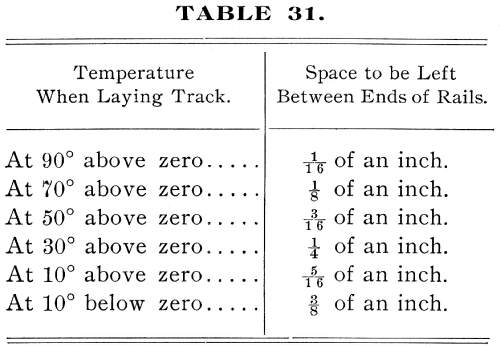|
1043
EXPANSION AND CONTRACTION.
1611. In laying track, provision must be made for expansion
and contraction of the rails, due to changes of temperature. As
the temperature rises the rail lengthens, and unless sufficient
space is left between the ends of the rails to allow for the expansion,
the ends of the rails abut one against another with such force
as to cause the rails to kink or buckle, marring the appearance
of the track and rendering it unsafe for trains, especially those
running at high speeds. If, on the other hand, too much space
is left between the rails, the contraction or shortening of the
rails due to severe cold may do equally great harm by shearing
off the bolts from the splice bars, leaving the joints loose and
unprotected. The coefficient of expansion, i.e., the amount of
the change in the length of an iron bar due to an increase or
decrease of 1 degree F. is taken at .00000686 per degree per unit
of length.
EXAMPLE.—If an iron rod measures 30.015 ft. at a temperature
of 90 degrees, what is its normal length, assuming 60 degrees
as the normal temperature? The temperature of the bar must be
90 degrees - 60 degrees = 30 degrees above the normal temperature.
SOLUTION.—As the increase in length is .00000686 ft. per
degree for each foot in length of the bar, the total increase
for 1 foot of the bar due to a rise of 30' in temperature is .00000686
x 30 = .0002058 ft., and for 30 ft. the increase in length above
the normal is .0002058 x 30 = .006174 ft , or about one-sixteenth
of an inch. As the rail at a temperature of 90 degrees measures
30.015 ft., of which length .00617 ft., say, .006 ft., is due
to expansion, the normal length of the rail is 30.015 - .006 =
30.009 ft.
1044
To provide against the effect, of expansion, an opening is
left between the ends of the rails, and to provide against contraction,
the holes in both rail and splice bar are made oblong, allowing
about ¼-inch for extreme movement. The following table
of expansion is a safe guide to track-layers for most latitudes
in the temperate zones:

To give to the track the proper opening at the joints, expansion
shims are used. They are made of iron, and are of various
forms. A simple and effective shim is made by bending a piece
of one-eighth inch iron into the form of a right angle, as shown
in Fig. 498.
This gives a combination shim of two thicknesses, viz., one-sixteenth
and one-eighth inches. After the angle is formed, the one-sixteenth-inch
shim is obtained by hammering the one-eighth-inch bar to the required
thickness. The thickness of each shim should be clearly stamped
upon it. When put in place, the shim reaches the full depth of
the head of the rail, and the bent portion lies flat on the top
of the rail. The shims should not be removed until the joint is
1045
full bolted, and there should be a sufficient number of them
on hand to keep the track-layers constantly employed, and not
require them to wait until shims can be removed from bolted joints.
Track Page
| Contents Page
|







